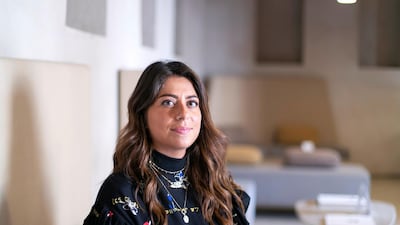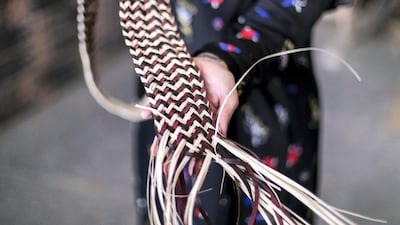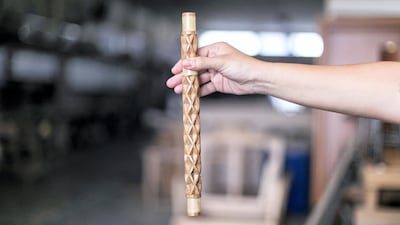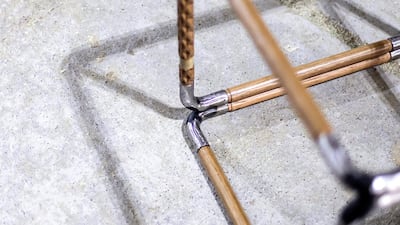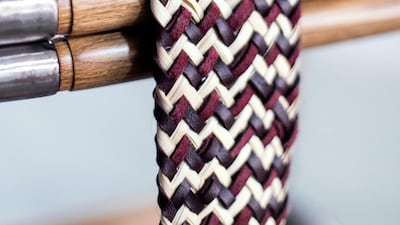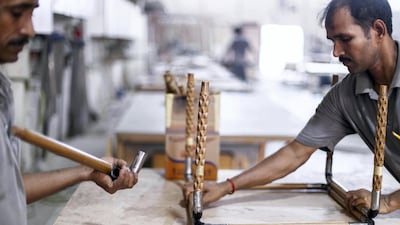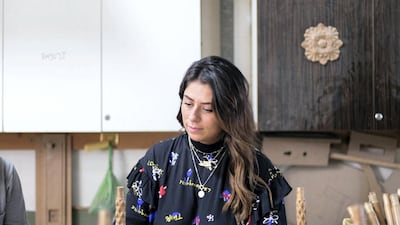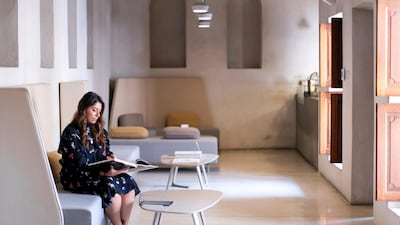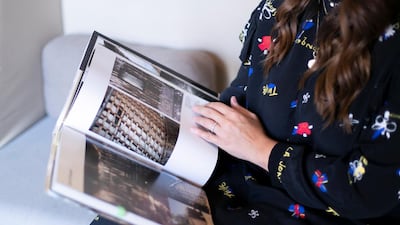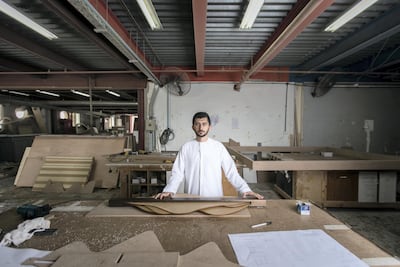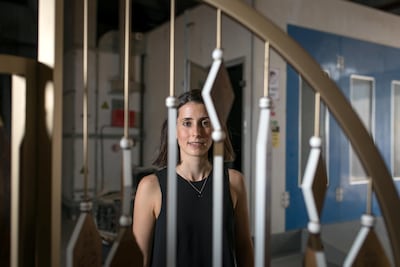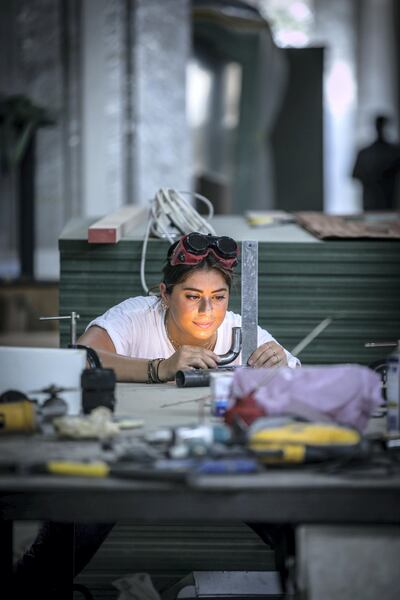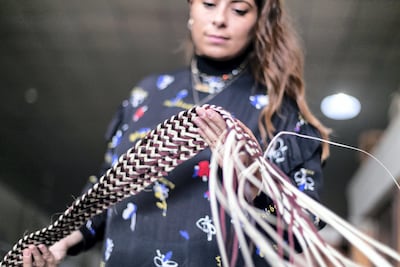Among the dusty depths of Sharjah's Al Ghuwair, affectionately called "Rolla" among residents, Lana El Samman meticulously inspects a tube of oak that's been carefully carved with a diagonal, geometric pattern along it.
"See? I knew you could do it," she says as she high-fives a concerned young man who, moments before, had nervously handed the designer a prototype. "One of the biggest challenges I've found is that manufacturers [in the UAE] are really good at creating something they've made before, but not so good at exploring new ideas and possibilities," she explains as we admire the handiwork of the team at Aden Furniture & Wood Factory in Sharjah.
“That’s something that could seriously improve the home-grown manufacturing industry – a culture of exploring. When I first asked the wood factory to try carving the pattern in the legs of my piece it was a real struggle to get them to even try it.”
Despite this challenge, the UAE has managed to successfully position itself at the forefront of the region's design movement, leading the way with Dubai Design Week, the fifth annual event of which will run at Dubai Design District from Monday, November 11 to Saturday, November 16. While a phalanx of art, design, interior and furniture businesses from all over the globe will descend on the emirate, what's notable is the need for more representation from UAE designers. The conversation around home-grown talent in the industry raises a bigger question about how artisans here are encouraged and nurtured.
It's not so much a fault of the fairs, but the lack of supply. Where are the contemporary, creative design brands building products from the ground up? The fact is that few exist. In an effort to tackle this problem, local arts organisation Tashkeel is currently hosting its sixth annual Tanween design programme, which aims to support and invest in young makers in the region, similar to how Warehouse421 does in the capital.
In December last year, three resident designers – Abdulla Al Mulla, Yara Habib and El Samman – were hand-picked from hundreds of applicants and, as a result, were granted access to funding, industry experts, equipment and mentoring, all to support the development of their own products. Furniture from the three designers will be released as a worldwide limited-edition run on Tuesday, November 12 at the event in d3.
_______________________________________
Meet the other Tanween Design Programme residents in 2019
An introduction to the creative professionals taking part in the Tanween design residency alongside El Samman this year at Tashkeel in Dubai.
Abdalla Al Mulla
The Emirati architect graduated with a bachelor’s degree in architecture from Woodbury University, San Diego, in 2014, where he was awarded the Grand Critique Faculty Choice Award, as well as the Best Degree Project Award based on his geometric explorations. After graduating, he worked for a government entity, managing construction projects. While this enhanced his technical knowledge, his passion for design led him to dedicate any spare time to participate in competitions, exhibitions, showcasing design installations and manufacturing furniture designs. Last year, Al Mulla decided to pursue a full-time career in architecture and design, and founded a studio called Mula.
Yara Habib
The Lebanese-Canadian designer Yara Habib lives in Dubai. She has a bachelor’s degree in graphic design from the Lebanese American University, as well as a master’s degree in graphic branding and identity from London College of Communication. Habib grew up in the UAE and developed a passion for patterns and colourful drawings at an early age. She continues to capture this in her work, which includes collections such as Layers by Yara, textured, three-dimensional wall art inlaid with intricate shapes carved from wood. It was exhibited at Made in Tashkeel 2019, which ran from June to September in Dubai. Ultimately, Habib seeks to tell stories and express feelings, and to imbue her work with aspects of her identity, which has been shaped by her time living, studying and working across the Emirates, Lebanon and Canada.
_______________________________________
Helen Voce, a contemporary design project specialist from the UK, and industrial designer and local mentor Kevin Badni, run the programme together. Applicants also have access to other industry professionals, such as British designer Gareth Neal, local graphic design guru Salem Al Qassimi and Studio Muju in Dubai, which is led by interior and furniture design duo Jumana Taha and Mentalla Said.
"Lana's portfolio showcased a hands-on approach to design and a conscious decision in finding ways to bring people together through her creations," says Salim Ahmed, Tashkeel's design coordinator, who was involved in selecting the final candidates for the programme. "Her technical experience gives her an edge. She demonstrated a clear understanding of materials and process using limited resources."
The only brief El Samman and her peers were given was that their product had to be functional, made in the UAE and reflect the country's culture. That's what brought us to this Sharjah factory one steamy Saturday afternoon, where, among the sawdust, El Samman, 30, shows me her first sample.
Her starting point was the nomadic lifestyle she experienced as a young girl moving between her native Lebanon, the UAE and Canada with her parents and brother. After graduating school, she moved to Canada, studying interior design at LaSalle College in Montreal. She then moved to Italy to study a master's degree at the Florence Institute of Design International. She returned to Dubai a decade ago, with a job as an assistant teacher at the University of Sharjah before landing a position as an interior designer at Sharjah Art Foundation, where we sit for a coffee after our factory tour.
El Samman – with guidance from her mentor and access to equipment and manufacturers provided by Tashkeel – has designed a commutable shelving system that marries modern functionality and traditional techniques.
"We're living in a world that's very transient; we don't buy heavy pieces that we plan on keeping forever. I wanted to create a modular piece of furniture because I wanted to give freedom to the client in how they use it and put it together. I wanted to create something that will evolve as the client grows and moves around."
Oak tubes are connected by hand-welded metal angles to make a stackable cube, the top surface of which is made up of a weave braided using palm leaves and camel leather. Sandra Piesik's book Arish: Palm-Leaf Architecture inspired El Samman.
“I was inspired by the architecture the UAE traditionally used to make houses,” she says, flicking through her own well-thumbed copy of the title. “Arish, a house made from palm leaves woven in this way, was very common in Bedouin culture and can stand for 20 years. The weave is extremely durable.”
She worked alongside a Bedouin woman at Sharjah Institute for Heritage to produce the braided textile, then updated the traditional technique by subsuming strips of camel leather – all sourced from a local environmentally friendly tannery – into the weave. It isn't unlike the signature material used by Italian luxury goods brand Bottega Veneta, and the result is starkly modern yet steeped in tradition. It's lo-fi luxury at its best and an antidote to the tropes of Arabesque furniture normally associated with regional decor. The wooden legs also feature a hand-carved pattern that's a nod to the weave arrangement; something that El Samman's woodsman triumphantly provided her with.
For Dubai Design Week, she has produced two pieces: a 50-centimetre by 50cm cube and a slightly lower version that would also work as a coffee table. She's called it Mokaab ("cube" in Arabic), and there will be a limited-edition run of 10 pieces each, all of which can be stacked and joined together with leather straps to create myriad shapes. The pieces will retail at Dh9,670 and Dh10,300, depending on size.
“They’re for anyone who appreciates handcrafted products, a story and a talking point behind a piece. I want to create a conversation. I love furniture with a story behind it so I want my designs to spark an exchange.”
Tanween is not the only local programme supporting young, regional trailblazers. The Irthi Contemporary Crafts Council also encourages local designers by working with female artisans from the wider region and Central Asia, while helping to preserve the UAE's age-old skills and rich heritage. Chaired by Sheikha Jawaher bint Mohammed Al Qasimi, the organisation showcases a range of traditional and modern crafts from local artists at trade fair Downtown Design, which starts on Tuesday, November 12.
Young Emirati designer Jawaher Alkhayyal, who lives in Sharjah, will also launch her first range of handcrafted furniture there. It's called the Sarab Collection and it, too, was inspired by traditional Emirati palm-weaving. While these collections signal a growing movement towards locally created and conceived products, more efforts need to be made to encourage young designers in the UAE, El Samman notes.
After nine years honing her craft at SAF, El Samman has started a new placement as a senior designer at the Dubai branch of Italian furniture design studio Molteni&C. The move, and the Tanween project, are all steps to establishing and evolving her own identity as an artist. She admits that while access to Tashkeel's little black book of manufacturers was invaluable in her process, she also spent hours wandering the dusty lanes of Al Quoz in Dubai and Rolla in Sharjah to find craftsmen to work with. Googling just didn't cut it.
"Companies need to be more approachable and invest in marketing," El Samman asserts. "Pricing is also a problem as there is no control. I found that quotes varied so much as there's no accountability, especially with young designers wanting to make custom-made pieces. Most manufacturers are used to working with contractors and not individual artists. There could be some support to bridge that gap."
At Tashkeel's Nad Al Sheba home, Ahmed hosts regular drop-in design surgeries to advise young makers. He says "clear communication is critical from both the manufacturers and designers".
“It is vital for the growth of the industry. Manufacturers need to be more active online to engage with their audience and demonstrate skills and what they can do and more importantly can’t do.”
Support and encouragement also needs to start at an academic level. Aside from Dubai Institute of Design and Innovation, there are limited dedicated design programmes in the UAE and very few elsewhere in the region, observes Tanween mentor, Badni.
“We have many talented students, and design is becoming recognised in the region as a major driver in the creative economy. I believe there is huge potential to develop local product design education that is grounded in the local culture and traditions but is forward and global-facing in its outlook.”
Dubai Design & Fashion Council currently offers young talent support by means of internships, mentorships, funding and workshops in various disciplines, but, says Badni, "from a wider perspective, it would be an excellent strategic initiative if the UAE would set up a Design Council focused on product design".
Tashkeel will continue to support the designers flying the Tanween nest by providing funding and resources for their product lines. This gives each one an invaluable jump-start in the market. The rest is kismet.
The UAE has a wealth of history to unpack and hybridise for any young designer taking cues from tradition. It’s clear we need more support to create a design generation, but, for now, Tanween and its alumni are helping the country evolve into an architect of modern makers. It’s a start.
A few Dubai Design Week 2019 events
Meet the Maker
Location: Ground floor, Building 10, Dubai Design District (d3)
Dates: Monday, November 11 to Saturday, November 16
Times: Monday-Friday, 10am-10pm; Saturday, 10am-5pm
Creatives from Make Works UAE are taking part in sessions throughout Dubai Design Week. They will conduct live demonstrations of various design techniques using materials such as leather, marble, wood and fabrics. Visitors can ask questions and gain insight on the processes, as well as open up wider discussions on manufacturing in the UAE.
Madar: A Design
Research Exhibition
Location: d3 Waterfront, Downtown Design
Dates: Tuesday, November 12-Friday, November 15
Times: Tuesday-Thursday, 5pm-7pm; Friday, 12noon-7pm
This exhibition focuses on the state of design in the Arab world, focusing on Lebanon, Egypt, Jordan, Palestine, Kuwait, Saudi Arabia and the Emirates. Themes explored will include craft preservation, material innovation and reducing manufacturing waste. The event will also highlight opportunities for up-and-coming designers, and empower them to design for positive change.
Design + Making UAE
Location: Ground floor, Building 10, d3
Dates: Monday, November 11-Saturday, November 16
Times: Monday-Friday, 10am-10pm; Saturday, 10am-5pm
Dubai arts hub Tashkeel, the founders of Tanween Design Programme, invites visitors to explore UAE design through exhibition stations, a programme of workshops, talks and conversations, as well as a retail pop-up of affordable products made by UAE talents.
Furniture Design for Sustainable Future
Location: The Workshop Dubai, Villa 45, Street 23B, Jumeirah 2
Dates: Monday, November 11-Saturday, November 16
Times: Monday-Friday, 10am-10pm; Saturday, 10am-5pm
This exhibition is a collaboration between The Workshop Dubai and Zinjaar Vintage. It aims to present a new generation of contemporary design based on refurbished and upcycled antique and vintage furniture.
Design Development in the UAE Symposium
Location: Warehouse 48, Alserkal Avenue, Al Quoz
Date: Tuesday, November 12
Times: 10am-1pm
This symposium is being hosted by Zayed University, exploring the development of design in the UAE. It presents a curated line-up of contemporary designers who are all based in the UAE. They will be revealing what it’s like to practise design in the country and how they developed their crafts. Speakers include Lina Ahmad, David Howarth, Karim Musfy, Omid Rouhani and Tina Sleiman.
A1 Safari Chair
Location: Ground floor, Building 7, d3
Date: Tuesday, November 12
Times: 10am-10pm
The Montroi Studio is revealing its A1 Safari Chair, which is made from UAE-sourced camel leather. The chair celebrates nomadism, and it can be folded and transported without the need to use tools. A talk will be held on the day to introduce it to the public.
Merchants & Makers Market
Location: Throughout Dubai Design District
Dates: Friday, November 15-Saturday, November 16
Times: Friday, 10am-9pm; Saturday, 10am-5pm
Ripe Market will host a two-day event in d3 that will feature stalls from more than 50 UAE brands. It will shine a light on creative entrepreneurs in the country and support small businesses and artisans, including artists, food producers and jewellers.
For more on Dubai Design Week 2019’s events, talks, exhibitions, installations and more, visit www.dubaidesignweek.ae/programme/2019

